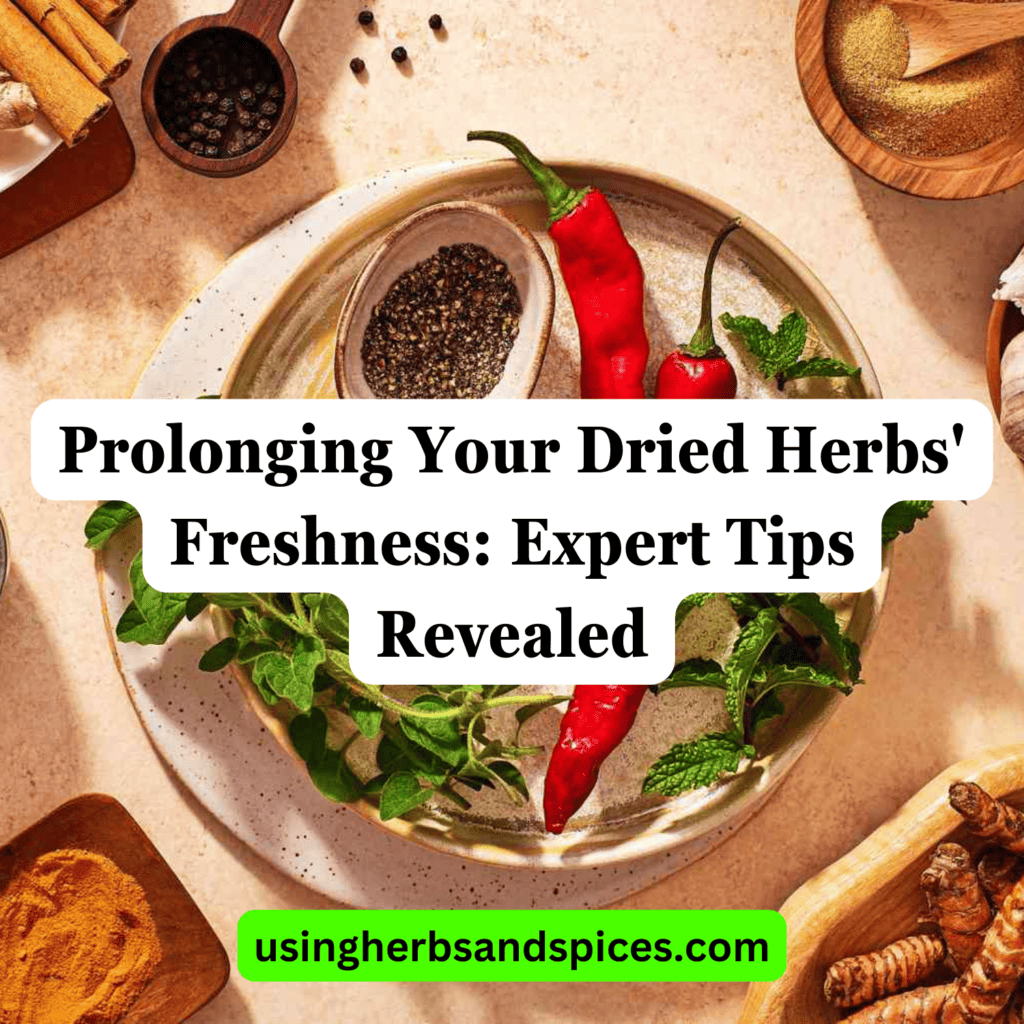When your cherished herbs begin to lose their zesty whisper, it’s not the end of their journey in your kitchen. You’re part of a community that values the aromatic contribution of herbs to every meal, and you understand the importance of keeping them at their best.

By unlocking expert tips on proper storage and care, you’ll ensure your dried herbs remain a vibrant part of your culinary creations. From avoiding common pitfalls to learning how to revive herbs that have lost a bit of their spirit, you’re about to become the guardian of enduring flavor.
Join us as we explore the simple steps you can take to keep your herbs’ essence alive in your comforting home recipes.
Table of Contents
Key Takeaways
- Most dried herbs maintain potency for up to a year when stored properly.
- Ideal storage conditions include hermetic sealing, temperature control, and dark-colored containers.
- Avoid common storage mistakes such as neglecting hermetic sealing and exposing herbs to light.
- Revive less-fresh herbs by assessing color and aroma, reintroducing moisture slowly, and evaluating the rehydration process.
Understanding Dried Herb Shelf Life
Before you can extend their life, you need to know that most dried herbs maintain their potency for up to a year when stored properly. Delving into the nuances of herb dehydration techniques is pivotal for both the longevity and the efficacy of your herbs.
Dehydrating herbs correctly means carefully controlling the temperature and humidity to preserve their essential oils, which are the carriers of flavor and aroma. When you’re a part of the community that treasures the essence of cooking, you’re not just preserving herbs; you’re safeguarding the soul of your culinary creations.
Should you find yourself with herbs nearing the end of their shelf life, it’s crucial to understand the art of culinary substitutions. A methodical approach is required here: analyze the flavor profile of the herb, consider the intensity, and then select a suitable substitute that will harmonize with the other ingredients in your dish.
Embracing this practice not only prevents waste but also invites you into a circle of resourceful cooks who prize adaptability in the kitchen. Remember, your herbs are more than seasoning; they’re a testament to your dedication to the craft of cooking.
Ideal Storage Conditions
To maintain your dried herbs’ peak flavor and potency, store them in a cool, dry place away from direct sunlight. The conditions in which you store your herbs are critical to preserving their quality. Here’s what you need to consider:
- Hermetic Sealing: This is paramount to prevent air, moisture, and contaminants from degrading your herbs. Use airtight containers with secure lids to create an impermeable barrier that maintains the herbs’ freshness.
- Temperature Control: Ensure the storage area maintains a consistent, cool temperature, ideally between 60-70°F (15-21°C). Fluctuating temperatures can lead to condensation and mold growth.
- Light Exposure: Herbs are sensitive to light, which can diminish their color and potency. Store them in dark-colored glass containers or in a cupboard to shield them from light damage.
Analyzing these elements, you’ll recognize the importance of creating a stable environment that mimics the herbs’ natural, dry state. By doing so, you’re not just storing herbs; you’re embracing a community of like-minded individuals who value the longevity and essence of their culinary assets.
Avoiding Common Storage Mistakes
After ensuring your dried herbs are stored under ideal conditions, it’s crucial to avoid common storage mistakes that can quickly diminish their quality.
One such error is neglecting hermetic sealing. This precise technique involves creating an airtight environment, which is vital for preserving the herbs’ potency. Without it, you’re allowing air, moisture, and contaminants to degrade your herbs’ flavors and medicinal properties.
To achieve this, meticulously inspect your storage containers for any signs of damage or wear. Ensure lids fit snugly, and if using jars with rubber seals, check for cracks or brittleness.
Light exposure is another adversary of dried herbs, sapping their vibrant colors and nuanced flavors. Your storage area should be as dark as possible. If you can’t avoid light entirely, opt for tinted containers that filter out the most harmful rays.
Reviving Less-Fresh Herbs
Transitioning from storage strategies, you’ll find that even with the best care, some dried herbs may lose a bit of their vigor over time. However, don’t be too quick to discard them; there are precise methods to revive their character and enhance your culinary creations. Herb rehydration can play a pivotal role in restoring a fresher aspect to your dried herbs.
Consider the following analytical steps to reinvigorate your herbs:
- Assess the herbs’ condition: Check for color and aroma as indicators of potential Flavor restoration.
- Prepare a rehydration process: Use cool, not hot, water to slowly reintroduce moisture without cooking the herbs.
- Test for effectiveness: After rehydration, evaluate if the herbs have regained some of their original pungency.
Methodically approach the rehydration process with attention to detail. Submerge the herbs in water for a short period—typically 10 minutes should suffice. After they’ve absorbed moisture, gently pat them dry with a paper towel.
This careful rehydration can help in reclaiming some of the herbs’ lost flavors and aromas, making you feel connected to the timeless tradition of cooking with well-preserved herbs.
Regular Herb Inventory Checks
You’ll maintain peak flavor and potency in your dried herb collection by conducting regular inventory checks. This systematic approach not only keeps your herbs at their best but also fosters a sense of community in shared culinary endeavors. Start by setting a schedule for your checks, be it monthly or quarterly, ensuring consistency in your routine.
During each inventory, employ herb rotation principles, much like a well-oiled pantry system. Move older stock to the front and newer purchases to the back. This not only ensures you’re using herbs before they lose their zest but also helps in identifying which herbs you use most frequently. With this knowledge, you can adjust your purchasing habits accordingly, avoiding excess and waste.
Incorporating inventory software can streamline this process, especially if you’re managing a sizable collection. These tools offer detailed tracking and can even alert you when it’s time to replenish your stock or when herbs are nearing the end of their prime.
Frequently Asked Questions
Can Different Types of Dried Herbs Be Stored Together in the Same Container Without Affecting Their Freshness?
Yes, you can store different herbs together, but be mindful of herb compatibility to avoid aromatic transfer, which can alter their distinct flavors and reduce their individual freshness.
How Does the Method of Drying Herbs (Air Drying, Dehydrating, Freeze-Drying) Impact Their Shelf Life and Freshness?
The drying method you choose weaves a tapestry of longevity for your herbs. Air drying is traditional but may be less consistent, while dehydrating and freeze-drying offer longer shelf life with proper packaging materials.
Are There Any Natural Preservatives That Can Be Added to Dried Herbs to Extend Their Freshness?
You can add herb antioxidants to your dried herbs to maintain their freshness. Reducing light exposure also helps, creating a sense of shared culinary tradition in protecting the essence of your cherished recipes.
How Can Fluctuations in Household Humidity Levels Impact the Freshness of Stored Dried Herbs?
Fluctuating humidity can hasten herb oxidation and increase light exposure risks, compromising your dried herbs’ integrity. You’ll want to monitor and adjust levels to maintain a sense of culinary community and shared quality.
Can Vacuum-Sealing Dried Herbs Significantly Prolong Their Freshness Compared to Traditional Storage Methods?
Yes, vacuum-sealing dried herbs can significantly enhance their longevity. This storage comparison shows that vacuum benefits include reduced air exposure, thwarting the stale fate that often befalls herbs in less protective environments.
Prolonging Your Dried Herbs’ Freshness
You’ve nurtured your garden, and now your dried herbs are like trusted tomes in a library, each with a story. Remember, even the best stories fade if not preserved properly.
By storing them in cool, dark places and avoiding moisture, you’re the guardian of their essence. Conduct regular checks, much like a librarian’s inventory, to ensure they remain vibrant characters in your culinary narratives.
Treat them with care, for in each pinch lies the distilled spirit of your garden.
